Time Travel Research Center © 2005 Cetin BAL - GSM:+90 05366063183 - Turkey / Denizli
The Intelligent and Practical Physics of UFO
Propulsion
Below are just a few
working scenarios for "Disc" or "Saucer" shaped vehicle drives.
By Paul E. Potter
Number 1}. Lazars Gravity Generating UFO the S4
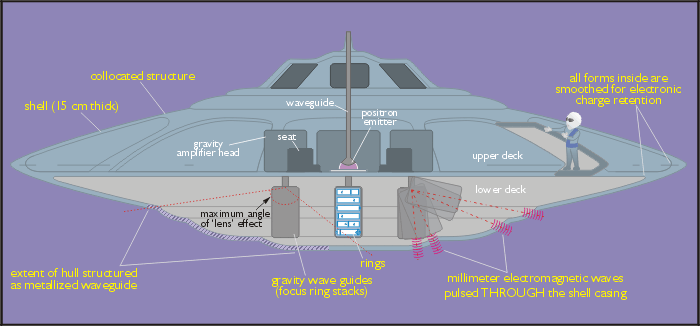
Bob Lazar's Gravity
Generators - by Paul E Potter
Zamanda yo
The following is the rubber
sheet explanation of space-time
manipulation by Bob Lazar. 1
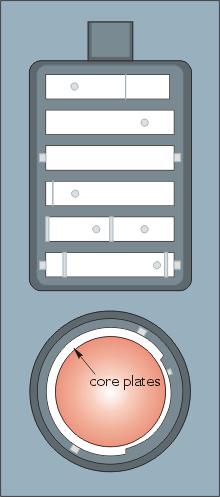 "Assuming
they're in space, they will focus the three gravity
"Assuming
they're in space, they will focus the three gravity
generators on the point they want to go to. Now, to give an analogy:
If you take a thin rubber sheet, say, lay it on a table and put
thumbtacks in each corner, then take a big stone and set it on one
end of the rubber sheet and say that's your spacecraft, you pick out
a point that you want to go to - which could be anywhere on the
rubber sheet - pinch that point with your fingers and pull it all the
way up to the craft. That's how it focuses and pulls that point to it.
When you then shut off the gravity generator[s], the stone (or
spacecraft) follows that stretched rubber back to its point. There's
no linear travel through space; it actually bends space and time and
follows space as it retracts. In the first mode of travel - around the
surface of a planet - they essentially balance on the gravitational
field that the gravity generators put out, and they can ride a "wave",
like a cork does in the ocean.* In that mode they're very unstable
and are affected by the weather. In the other mode of travel - where
they can travel vast distances - they can't really do that in a strong
gravitational field like Earth, because to do that, first of all, they
need to tilt on their side, usually out in space, then they can focus
on the point they need to with the gravity generators and move on.
If you can picture space as a fabric, and the speed of light is your
limit, it'll take you so long, even at the speed of light, to get from
point A to point B. You can't exceed it - not in this universe anyway.
Should there be other parallel universes, maybe the laws are
different, but anyone that's here has to abide by those rules.
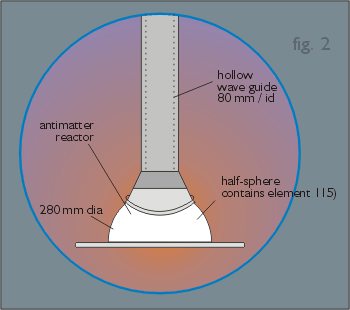 "Inside
the reactor,
"Inside
the reactor,
Element 115 is
bombarded with a proton
which plugs into the
nucleus of the 115 atom
and becomes Element
116, which immediately
decays and releases, or
radiates, small amounts
of antimatter.
The antimatter is released
into a tuned tube which keeps it
from reacting with the matter that surrounds it. It is then
directed toward a gaseous matter target at the end of the tube.
The matter and antimatter collide and annihilate, totally
converting to energy. The heat from this reaction is converted
into electrical energy in a near 100% efficient thermoelectric
generator..." 1
Element 115 is a superheavy element found probably on a
planet of a binary star system. Supposedly the craft uses 223
grams, cut to a triangular shape, within the reactor structure, [in
a cloud chamber it was shown to alter, by gravitational forces,
the paths of released alpha particles].
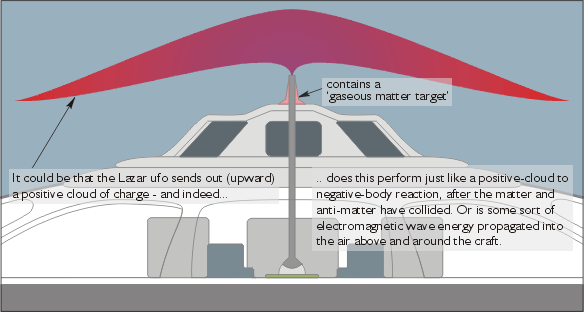
The thing about Lazar's
central tube assembly, which he doesn't make mention of, is that it
surely must be used as a circular cross-section waveguide for high-frequency
waves. From his
graphics it looks like an 8cm tube and that would relate to an
electromagnetic wave in the
microwave region (especially if the tube terminated at the top at a smaller
diameter). And
whatever the target is, hitting it with these microwaves most probably
causes the molecules and
atoms of the target 'gases' to resonate (as in electron spin resonance), the
resonance then pulls
the electrons up the energy bands and greatly increases their energy level.
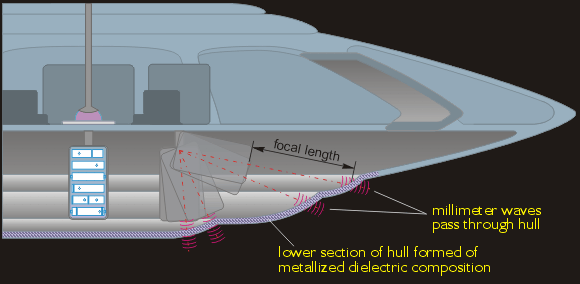
If you look at the graphic (fig.5) above you will see three sections of the
bottom of the hull
especially curved, and each of these curved sections because they are
differently spaced from the
wave generators have a different "focal length" (to use a photographic term),
and because at
different focal lengths the wave's shape will be different as it enters the
dielectric waveguide
lens then the resultant wave produced by that lens-waveguide when that wave
passes through it
will also be different. Couple to this the fact that for every different
angle that the waves pass
through the dielectric hull a different effect of refraction will occur to
the wave. Consider next
that if this craft uses the two outer generators to focus their two
microwave-beams at some
finite point in the distance it would follow that to approach that same
point in space the two
beams will have traversed through a different thickness of the dielectric
lens, and at a different
angle, meaning that the two beams will be shaped slightly differently. If,
then, it can be
controlled how the two waves are shaped then it will also be possible to
control their
constructive and destructive interference pattern - and hence the strength
or weakness of the
electric field at the area where the two beams approach each other. And as
you already know the
stronger the electric field the stronger the repulsion - the stronger the
acceleration.
Z
Number 2}. UFO Plasma Engine and Dr.
Jean-Pierre Petit's current MHD Research
Zamanda yolculuk ©
"Three leading French physicists claim to have made a 'sensational
breakthrough' into the
mysteries of how UFOs are powered. Dr. Jean-Pierre Petit, Dr. Claude Poher
and Dr. Maurice
Viton, have constructed what they term a UFO engine or, The Petit-Viton
Magnetohydrodynamic Motor by using, so they say, a combination of both
electromagnetic and
nuclear energy. The French scientists claim fantastic results and tremendous
power output in
the order of 1,000 million watts. The ufo engine was built at the
Astronomical Observatory in
Marseilles. Possibly one of the most amazing developments of the French ufo
engine, is that the
physicists claim to have discovered how to suppress the shock waves which
slow down any
object moving through the air. Petit said: "It all comes down to standard
physics. An
electromagnetic field can create a low pressure area under an aerodyne, or
flying saucer. To this
can be related the peculiar property of plasma. Plasmas magnetic field is
frozen inside while it
expands at unimaginable speeds, producing an electrical current. Using
plasma, a belt of free
air can be created. The molecules of air in front of this belt are pushed
aside without piling on
top of each other, as they do when a normal aerofoil passes through the
atmosphere fast enough
to break the sound barrier. Were not saying weve solved the problem, but
we think we have
cracked the principle behind the effects observed in unidentified-flying-objects".
As a matter of interest, one of the physicists who co-developed the ufo
engine is now head of an
official French ufo research group. Dr. Claude Poher, formerly in charge of
the Astronomy
Department, Scientific Systems, Projects Division and Sounding Rockets
Division of the French
National Centre for Space Studies (CNES), is now director of GEPAN (Groupe
d'Etude des
Phenomenes Aerospatiaux Non Identifies)".
[The above information was sourced from a book called "Prehistoric Germ
Warfare" by Robin
Collyns (1980), which gave its source as Australasian Post (from Los
Angeles) dated March 31
1977 from an article on the French Ufo Motor by Bernard D. SCOTT.]
Below are further details of other original papers and current website links.
Extracts taken from J.P. Petit's MHD webpage (see link at end)
Zam
Following, the three first illustrations. In figure 1, a disk-shaped machine,
with an equatorial
solenoid, whose alternating electric current creates an alternating magnetic
field. This one
(thanks to Mr Maxwell) creates an induced electric field E' which tends to
create circular induced
electric currents. Combining these currents J' to the instant value of the
magnetic field we get
radial forces (Hall effect is considered as negligible); we get a system of
time-dependent radial
forces J ' x B, which are directed towards the outside and towards the
center, alternatively. So
that the idea was as the following : Suppose we can create a non-steady
ionization at the vicinity
of the disk, controlled in time, we could act on the fluid, using radial
centrifugal forces when
they are present, of the top of the disk and radial centripetal forces, when
this force is reversed,
at the bottom of the disk-shaped machine [as in figure 3].
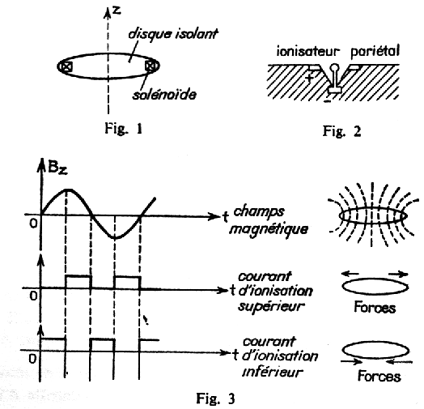
Za
...On the next figure [figure 4], the expected induced gas flow; around our
disk-shaped machine :
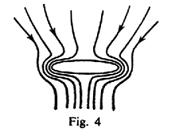 Z
Z
...The computations said
that the suction effect could be very strong, strong enough to cancel
any shock wave formation at the stagnation point of the machine (it moves
along its axis). The
technical problem was to modulate the ionization at the vicinity of the wall,
in time. We
imagined first a device looking like a "wolf trap" :
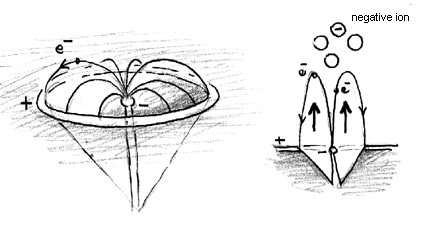
...Imagine a "small size" conical hole, in the wall and, along its axis, a "pin".
At the junction of the
cone-plane, a circular electrode (anode). The central electrone (pin like)
is charged negatively.
Then an electric discharge forms in the surrounding air, as shown above. The
subsequent
magnetic field, associated to this electric discharge, tends to push the
free electrons away and to
give them energy. We thought that it could produce short-lifetime negative
ions in air, making
possible MHD interaction during the lifetime of such ions. In a well equiped
lab such research
could have been carried out, but we had none. Since 1973 I was in an
astronomical observatory,
which is not an optimum place to perform plasma physics experiments.
...Anyway, at the end of the seventies, some interesting aspects of the
machine were discovered.
Good plasma specialists know that magnetic pressure tends to blow away
electric discharges.
We experienced that in low pressure air experiments. The solution was
rapidly found. Instead of
creating a B field whose maximum value was in the symmetry plane (created by
a single
equatorial coil), we decided to use three, a big one and two smaller, as
shown on the next figure
[see figure 5]:
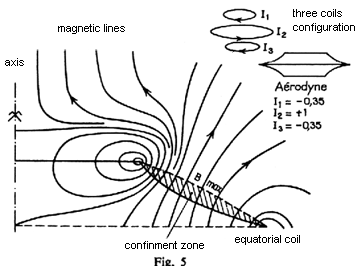
T
...To the left of this figure is the axis of the machine. At the top-right
is the schematic disposition
of the three coils, showing the way the electric currents flow in. On the [main]
figure, the
magnetic lines. We see that the maximum B surface is close to a portion of a
cone (containing the
circles of two coils). The gray [shaded] area represents the confinement
volume, in which the
plasma tends to lie. Immediate success, experimentally. Then the wall of the
machine, to
optimize the MHD interaction, must be orthogonal to the magnetic lines.
Finally, this is the
typical aspect of our electrodeless MHD aerodyne, using induction phenomena
and pulsed
ionization, optimized on MHD grounds :
Z
...You see why we got some problems with the scientific community, army,
politicians, and so on.
...Short-duration ionization was difficult to manage.
Cold gas MHD experiments.Z
...But, recently, a new idea came, which is summarized in the following
figure :
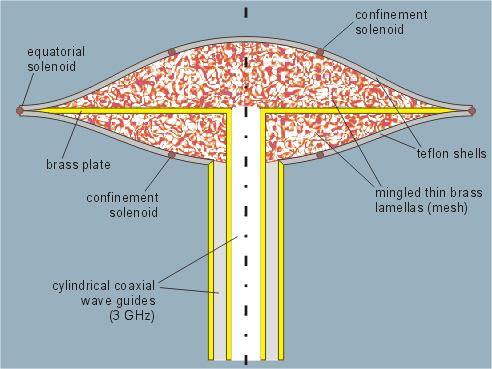
...The walls of the model are made of teflon. In the two teflon shells,
coils are imbedded (the
equatorial one and the two "confinement coils"). Two klystrons will be used,
connected to two
separate wave guides. These two are shown on the figure. They are coaxial
brass cylinders.
When one is in operation, the second one is out, and so on. Mingled thin
brass lamellas (red) act
as a diffuser and spray microwaves. The brass plate located in the plane of
symmetry prevents
the microwaves used from ionizing the air on the opposite side of the
machine. In the next
figure we show the model when the microwaves flow along the central channel,
and are
diffused by the thin mingled brass lamellas, in the top part, then cross the
teflon and create a
thin layer of ionized air. 3 GHz microwaves are optimum to ionize
atmospheric pressure air, and
ionized gaz absorbs microwaves. For this reason the ionization will be
confined in a thin layer

For more details of current research projects in both MHD and Cosmology (see
Jean-Pierre
Petit's MHD and his thought provoking Cosmology websites).
Although the technology here is vastly different to that described by Bob
Lazar, one might
nevertheless notice a similarity in the concept of Lazar's anti-matter wave
tube and his
microwave analogy.
Çetin BAL, Zamanda yolculuk, Zaman Makinesi, Time Travel, Solucan deliği, wormhole, Warpdrive
Hiçbir yazı/ resim izinsiz olarak kullanılamaz!! Telif hakları uyarınca bu bir suçtur..! Tüm hakları Çetin BAL' a aittir. Kaynak gösterilmek şartıyla siteden alıntı yapılabilir.
The Time Machine Project © 2005 Cetin BAL - GSM:+90 05366063183 -Turkiye/Denizli
Ana Sayfa /İndex /Roket bilimi / ![]() E-Mail /CetinBAL /Quantum Teleportation-2
E-Mail /CetinBAL /Quantum Teleportation-2
Time Travel Technology /Ziyaretçi Defteri / UFO Technology